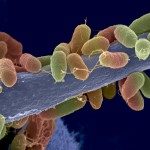Link to Pubmed [PMID] – 29414772
J. Biol. Chem. 2018 Mar;293(13):4901-4912
Surfactant protein D (SP-D), a C-type lectin and pattern-recognition soluble factor, plays an important role in immune surveillance to detect and eliminate human pulmonary pathogens. SP-D has been shown to protect against infections with the most ubiquitous airborne fungal pathogen, , but the fungal surface component(s) interacting with SP-D is unknown. Here, we show that SP-D binds to melanin pigment on the surface of dormant spores (conidia). SP-D also exhibited an affinity to two cell-wall polysaccharides of , galactomannan (GM) and galactosaminogalactan (GAG). The immunolabeling pattern of SP-D was punctate on the conidial surface and was uniform on germinating conidia, in accordance with the localization of melanin, GM, and GAG. We also found that the collagen-like domain of SP-D is involved in its interaction with melanin, whereas its carbohydrate-recognition domain recognized GM and GAG. Unlike un-opsonized conidia, SP-D-opsonized conidia were phagocytosed more efficiently and stimulated the secretion of proinflammatory cytokines by human monocyte-derived macrophages. Furthermore, mice challenged intranasally with wildtype conidia or melanin ghosts ( hollow melanin spheres) displayed significantly reduced proinflammatory cytokines in the lung compared with wildtype mice. In summary, SP-D binds to melanin present on the dormant conidial surface, facilitates conidial phagocytosis, and stimulates the host immune response.
